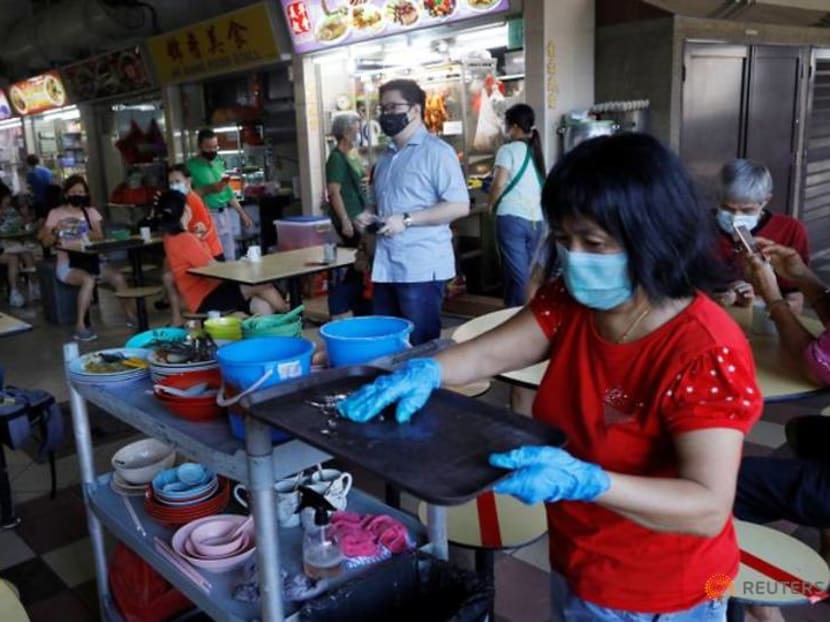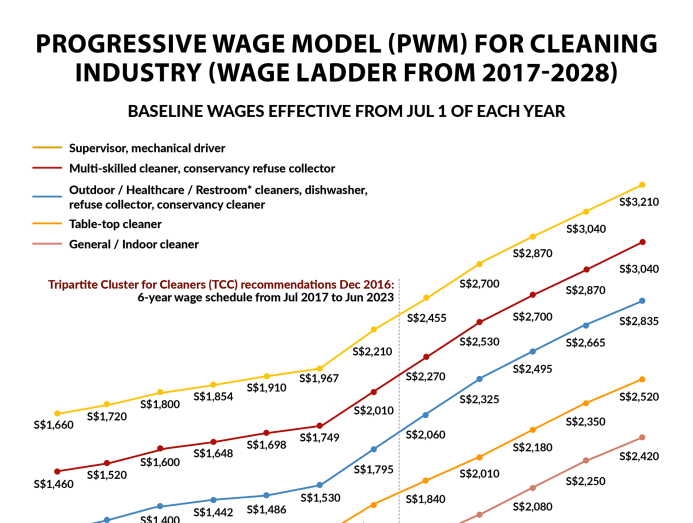What would it take to attract younger workers to the cleaning industry?
In announcing new wage levels for workers in the cleaning sector, NTUC assistant director-general Zainal Sapari said: "We want to attract a younger workforce into this industry. We want this to be a possible career that they can consider, compared to going into the gig economy."

A cleaner clear dishes as people dine at a hawker center in Singapore as the city state reopens the economy amid the coronavirus disease (COVID-19) outbreak, June 19, 2020. REUTERS/Edgar Su
SINGAPORE: Student Jayden Mani, 23, says that he earned up to about S$8,000 a month as a full-time food delivery rider after he completed National Service last year.
But this meant working 16-hour days a week with no benefits, job security or Central Provident Fund contributions. He once got into an accident and was laid up for two weeks with no income, he recalled.
Now a nursing student, he still does food delivery part-time. The job allows him flexibility to pursue his studies, but he thinks it’s not a long-term option. He chose nursing as he thinks it will be a meaningful career, he said.
When asked if he would consider joining the cleaning industry, he looked doubtful, saying: “The stereotype is that if you’re a cleaner, you have no future.”
READ: Cleaners’ wages to rise from 2023 amid COVID-19 labour crunch
Earlier this month, the Tripartite Cluster for Cleaners (TCC) mapped out new wage levels and skills requirements for workers in the cleaning industry, with higher salary increments planned for the next six years under the Progressive Wage Model (PWM).
This review of the PWM wage levels came as calls to value and appreciate essential workers, such as cleaners, have grown louder during the COVID-19 pandemic. It also comes amid a labour crunch as border restrictions has limited the inflow of low-wage foreign workers.
Chairman of the TCC and NTUC assistant director-general Zainal Sapari said then: "We want to attract a younger workforce into this industry. We want this to be a possible career that they can consider, compared to going into the gig economy."
Elaborating on this call to join the industry, Mr Zainal said that gig jobs do not offer much in terms of skills upgrading for better career advancements.
“These workers would be better off in the long-run rather than staying on a full-time basis as delivery riders or private-hire drivers,” he said in an interview with CNA Digital on Wednesday (Jun 16).
“In fact, for cleaning, workers who are willing to be trained to be a multi-skilled cleaner, could see themselves earning as much as a fresh ITE graduate by 2023.”
NARROWING THE INCOME GAP
The basic entry-level wage of a cleaner is is now S$1,236. With recommended PWM increments, it’s set to rise to a range of S$1,570 to S$2,210 in July 2023.
With faster pay jumps over the next six years, it will reach a range of S$2,420 to S$3,210 by 2028.

A number of delivery riders CNA spoke to pegged a basic pay to “survive” at S$2,500 to S$3,000. In particular, those with families said that this was a minimum income required to afford the necessities.
When asked about this, Mr Zainal said that his father, a cleaner and his mother, a hospital attendant, raised five children.
“My response would be for them to consider having a dual income household. More importantly, hold on to a job that offers income and job security,” he said.
“You can still work in the gig economy to supplement your income. My father worked as a security guard after finishing his job as a cleaner to get extra income.”
Singapore’s social support system such as Workfare Income Supplement and financial assistance schemes can help supplement the family income, he added. But ultimately, the goal is to narrow the gap.
READ: There's 'always a risk': How cleaning companies in Singapore are keeping its employees safe amid the COVID-19 pandemic
“We must continue to find ways to narrow the income gap and ensure their average wage growth continues to be higher than the average workers’ wage to strengthen our social compact,” said Mr Zainal.
The desired outcome is that workers in the 20th income percentile be earning two-thirds of the median income, while for now, their wages are at half of the median income, he added.
Singapore’s median wage was S$4,534 in 2020 and median income growth was 2.6 per cent per annum from 2015 to 2020.
NOT JUST ABOUT PAY
However, pay is only one part of the conundrum. With jobs like cleaning, the hard work, long hours and stigma attached can also deter people from taking it up.
But some see hope as the pandemic seems to have led to new-found appreciation for essential workers.
Calling cleaning a “sunrise industry”, president of Environmental Management Association of Singapore (EMAS) Tony Chooi said that demand for cleaning and disinfection services will keep increasing in the new normal.
READ: IN FOCUS: How fewer migrant workers means challenges beyond the construction sector
He thinks that there are ways to uplift the image of the industry, and improve its professionalism. Young people would need to see that there are opportunities and a career path for them, he said.
“There are two sides to most jobs and while cleaning is not the most glamorous of industries, its nature and scope has changed through the years with exciting developments in, for example, robotics and technology,” he said.
It’s a “stable yet progressive career”, he added: “While we can agree that the gig economy offers more flexibility and better working conditions, there is also no work stability and career path.”
“SEVERE SHORTAGE OF CLEANERS”
He admits that the negative perception of the industry is harder to change, and will take time. But it’s time that the industry can ill afford as there has been a decrease of about 11 per cent of the workforce hired by licensed cleaning companies since 2016.
The attrition has been due to due to retirement, workers leaving the industry and a reduction in the foreign worker quota, as well as a lack of new entrants. The average age of the cleaning workforce is 60 years old, according to EMAS.
Meanwhile, the demand for cleaning services has grown.
“If we do not attract the younger workforce, there will be a severe shortage of cleaners,” said Mr Chooi. “Going forward, the industry is pushing for outcome-based contracts and adoption of technology plays a key role in its success. It is also easier for the younger people to pick up technology-related skills.”
By re-designing jobs, improving professionalism and raising wages, Mr Zainal believes that essential workers will come to be seen as specialists in their field and not a “low-wage workers”.
“I wish there’s a magic wand (which) would change society’s perception instantly, but the reality is we have to do something different, and cumulatively, I think it will happen,” said Mr Zainal.
“I believe that in time to come, with shifting perceptions and recognition of the importance of work in the essential service industries, the workers will have greater pride in their jobs when they are truly valued by society.
“I would consider the changes we are making for the cleaning industry and the other essential services industries as well as a start of a new normal for essential service workers that keep Singapore safe, clean, and green.”





